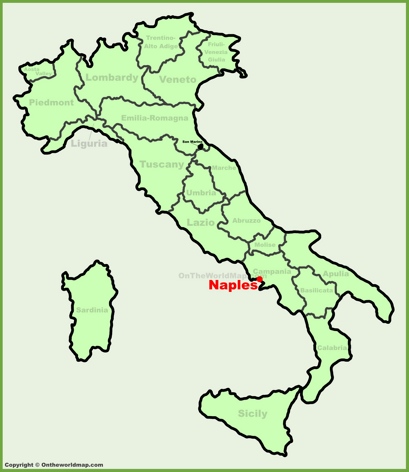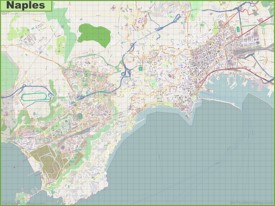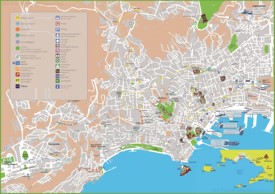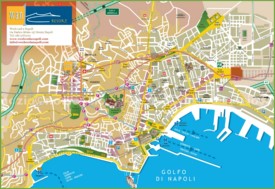Naples Map
Description:
This map shows streets, roads, buildings, hospitals, parking lots, shops, churches, restaurants, cafes, hotels, theaters, museums, piers, public toilets, railways, railway stations and parks in Naples.
Author: Ontheworldmap.com
Map based on the free editable OSM map openstreetmap.org.
You may download, print or use the above map for educational, personal and non-commercial purposes. Attribution is required. For any website, blog, scientific research or e-book, you must place a hyperlink (to this page) with an attribution next to the image used.
Online Map of Naples
About Naples (Napoli)
Naples, known as "Napoli" in Italian, is the capital of the Campania region in southern Italy. It is the third-largest city in Italy, following Rome and Milan, and serves as a major cultural, economic, and historical center. The city is located on the western coast of Italy, along the Gulf of Naples, and is in close proximity to the famous volcano, Mount Vesuvius. Naples is situated on the Bay of Naples, which is part of the larger Tyrrhenian Sea. The city's geographical setting is notable for its proximity to both natural beauty and geological activity, with Mount Vesuvius being one of the most famous active volcanoes in the world. The climate in Naples is Mediterranean, characterized by hot, dry summers and mild, wet winters. As of the latest estimates, Naples has a population of 907,484[1] people within the city proper, with a larger metropolitan area that includes over 3 million inhabitants. The city is known for its vibrant street life and densely populated neighborhoods.
Landmarks and Attractions
Historic Centre of Naples: Designated as a UNESCO World Heritage Site, the historic center of Naples is a maze of narrow streets filled with ancient churches, palaces, and archaeological remains. Key sites include the Spaccanapoli, a long, straight street that divides the old city, and the Naples Cathedral, known for housing the relics of San Gennaro, the city's patron saint.
Naples National Archaeological Museum: One of the most important archaeological museums in the world, it houses an extensive collection of Roman artifacts, including many from the nearby sites of Pompeii and Herculaneum.
Castel Nuovo (Maschio Angioino): A medieval castle that serves as a symbol of the city, it was built in 1279 and has been a royal residence and fortress throughout its history.

Royal Palace of Naples: Located in the Piazza del Plebiscito, this historic palace was the residence of the Bourbon kings during the Kingdom of the Two Sicilies.


Teatro di San Carlo: The oldest continuously active opera house in the world, founded in 1737, it is renowned for its exquisite architecture and acoustics.
Vesuvius National Park: A short distance from the city, this park offers hiking trails up Mount Vesuvius, providing panoramic views of the Bay of Naples and the surrounding region.
Pompeii and Herculaneum: Although not within the city limits, these ancient Roman towns, preserved by the eruption of Mount Vesuvius in AD 79, are significant archaeological sites easily accessible from Naples.
Capodimonte Museum: Situated in the Capodimonte Royal Palace, the museum houses an extensive collection of art, including works by Caravaggio, Raphael, and Titian.
Sansevero Chapel: Known for the Veiled Christ, a remarkable marble sculpture by Giuseppe Sanmartino, the chapel is a masterpiece of Baroque art.
The history of Naples spans over 2,800 years, making it one of the oldest continuously inhabited urban areas in the world. The city was founded by the Greeks in the 8th century BC and was originally named "Neapolis," meaning "new city." Over the centuries, Naples has been influenced by various cultures, including the Romans, Byzantines, Normans, and Spanish, each leaving a distinct mark on the city's architecture, culture, and traditions.
Naples is an important economic hub in Italy, with a diverse economy that includes sectors such as tourism, commerce, industry, and agriculture. The Port of Naples is one of the largest in the Mediterranean and plays a crucial role in the city's economy, facilitating trade and transportation. Naples is renowned for its rich cultural heritage, which includes a strong tradition in music, art, and cuisine. The city is the birthplace of the traditional Italian pizza and is famous for its unique style of music, including the Neapolitan song. Naples has also been a significant center for opera and theater.
Naples is served by Naples International Airport (Aeroporto di Napoli-Capodichino), which provides domestic and international flights. The city has an extensive public transportation network, including buses, trams, and a metro system. The Circumvesuviana railway connects Naples with nearby towns and tourist attractions such as Pompeii and Sorrento.
The Facts:Region: Campania.
Province: Metropolitan City of Naples.
Area: 45 sq mi (117 sq km).
Population (2024): 907,484.[1]
Website: www.comune.napoli.it
References
1. Demografia in cifre. Italian National Institute of Statistics.Maps of Italy
Cities of Italy
Cities of Italy
Regions of Italy







